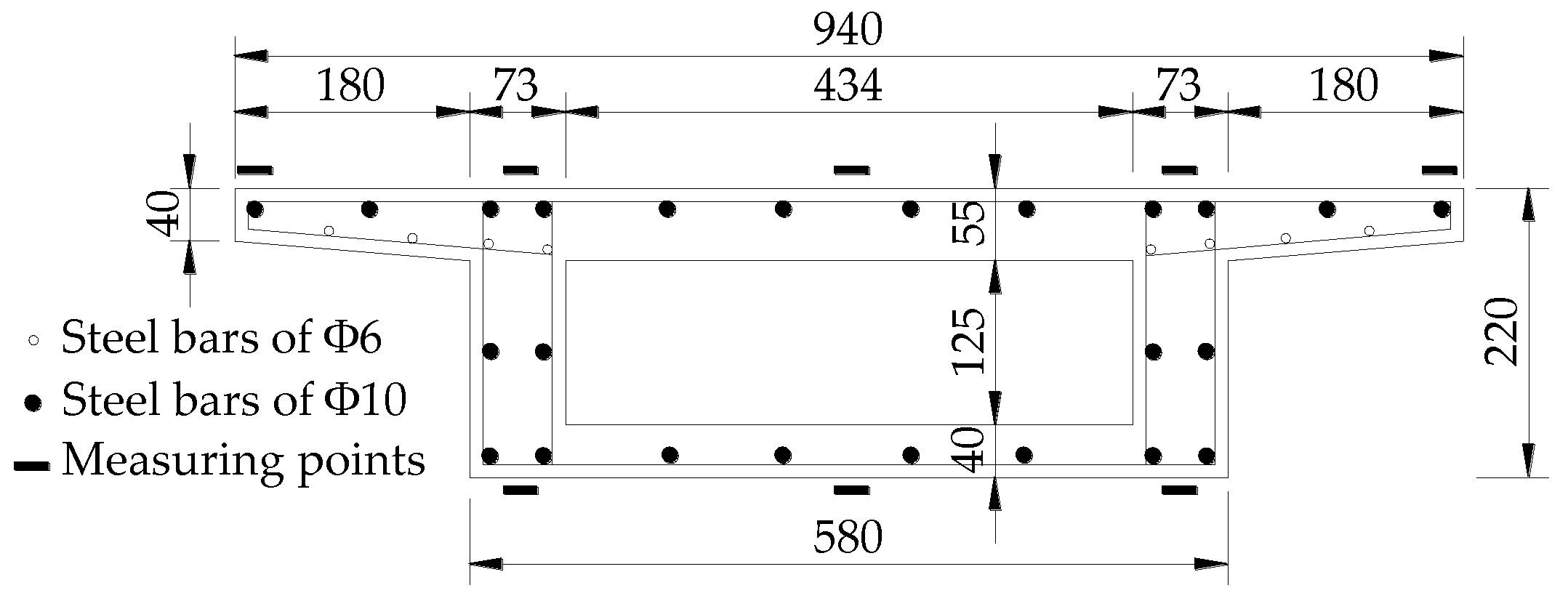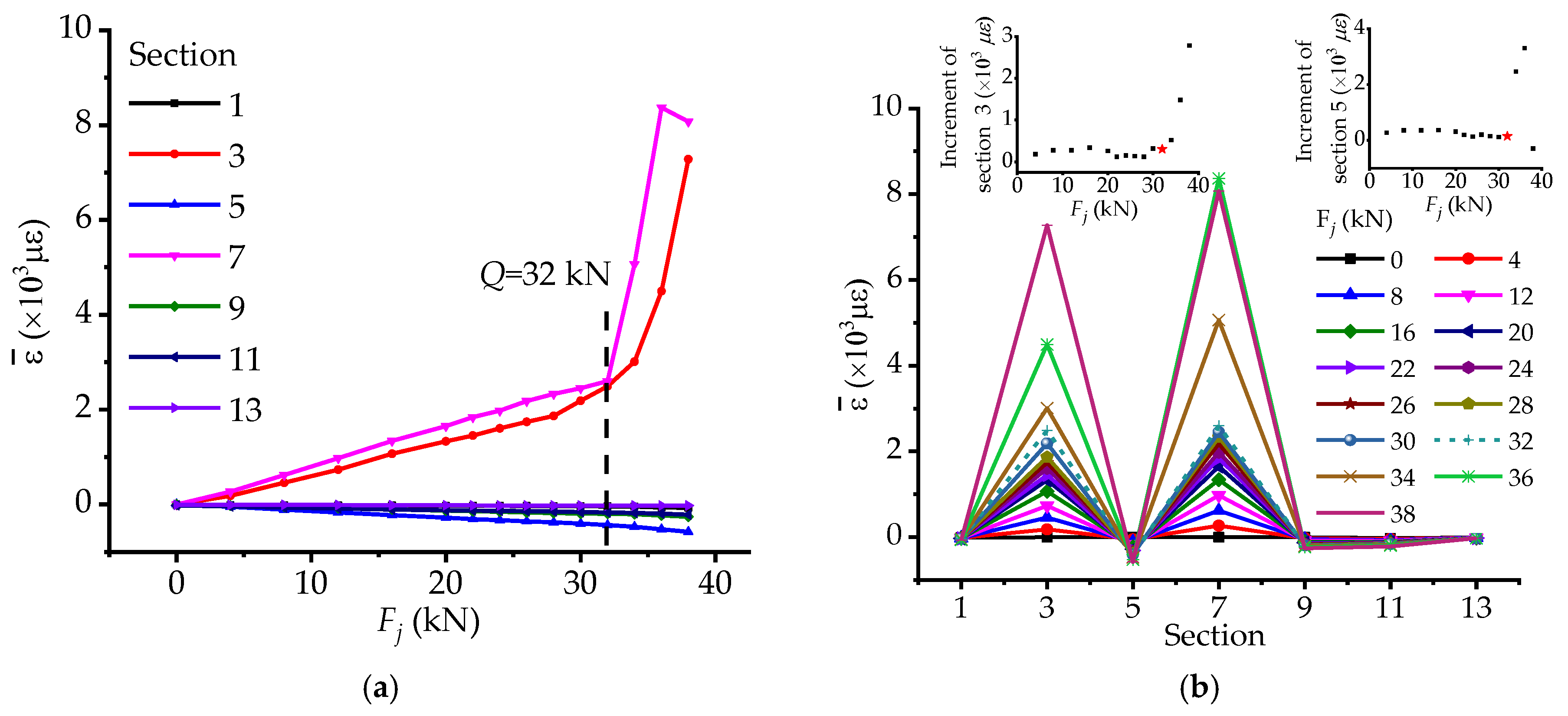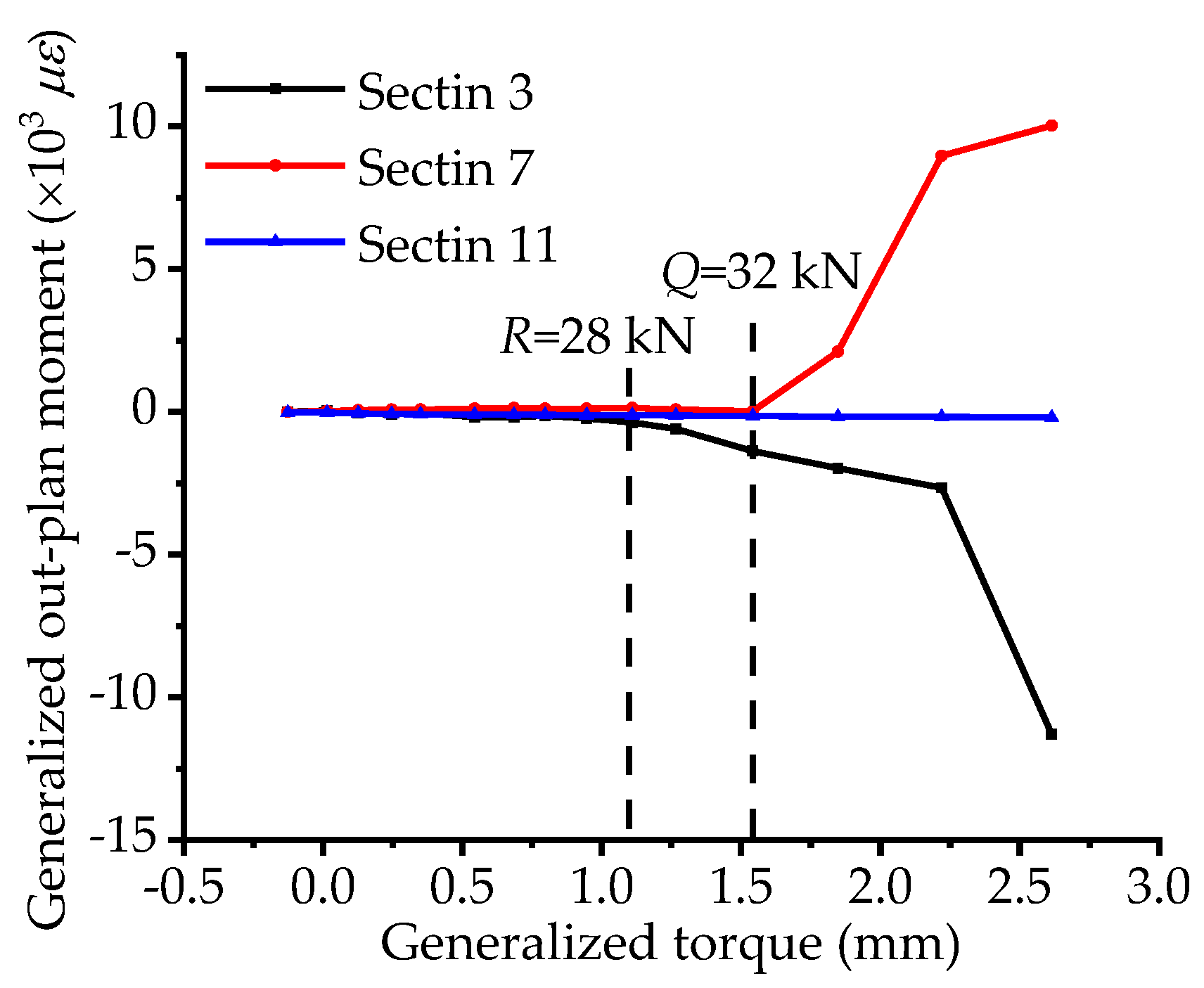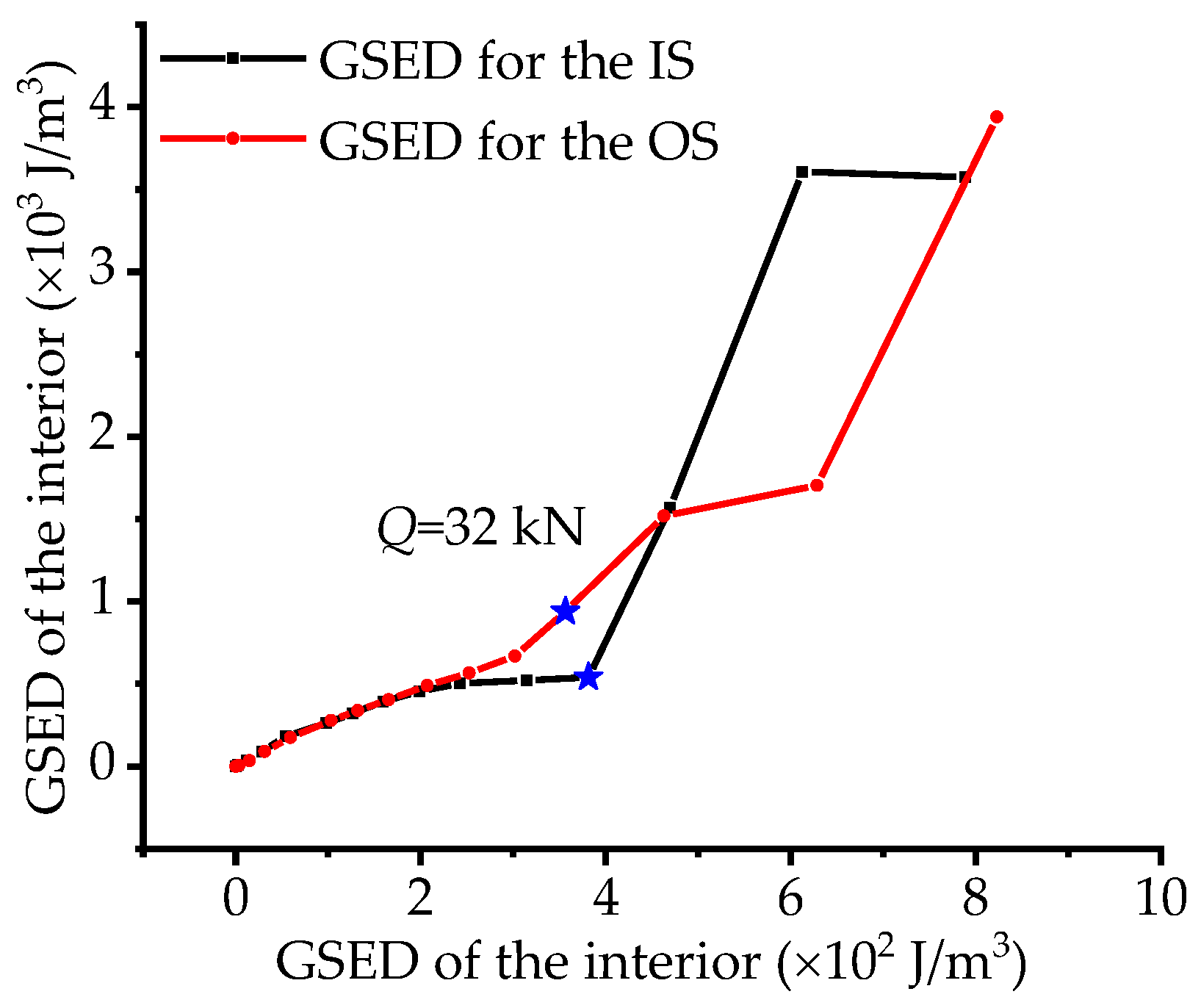Stressing State Analysis of an Integral Abutment Curved Box-Girder Bridge Model
Abstract
1. Introduction
2. Structural Stressing State and M-K Criterion
2.1. Structural Stressing State Concept
2.2. Numerical Description of Structural Stressing State
2.3. M-K Criterion
3. Experimental Bridge Model
3.1. Configuration of the Bridge Model
3.2. Measuring Point Arrangement
3.3. Loading Scheme
4. Analysis of the Bridge Model’s Stressing State Characteristics and its Parameters
4.1. GSED-Based Stressing State Mode and Characteristic Parameter
4.2. Analysis of Stressing State Modes Based on Displacements and Strains
4.3. Component Stressing State Mode
4.4. Coordinate Working Features of the Bridge Model
5. Conclusions
- The normalized GSED values can effectively model structural stressing state and reflect their working behavior features. The M-K criterion is applied to detect failure load Q through Ej,norm-Fj curve, hence two stressing state stages of the bridge model are separated in its whole loading process. Then the effectivity and rationality of the M-K criterion are verified through the analyses of strain-based and DSPL-based stressing state modes, component stressing state modes and correlation features of characteristic parameters.
- The concept of component stressing state modes is proposed based on the inherent in-plane and out-plane bending and torsional behavior of the bridge model, which is modeled by the average displacement, strain difference, and displacement difference. And the working behavior of the bridge model under different internal forces and their roles in the structural failure process could be reflected as well.
- The concept of structural coordination working behavior is proposed based on the coupling relationship of different internal forces and structural response under load, which modeled by the generalized torsional and out-pane bending behavior and the GSED of exterior and interior. Coordinate curves diverted from this concept can characterize the structural coordination working behavior features and reflect qualitative mutation characteristics as well.
Author Contributions
Funding
Acknowledgments
Conflicts of Interest
References
- Zordan, T.; Briseghella, B.; Lan, C. Parametric and pushover analyses on integral abutment bridge. Eng. Struct. 2011, 33, 502–515. [Google Scholar] [CrossRef]
- Arockiasamy, M.; Butrieng, N.; Sivakumar, M. State-of-the-art of integral abutment bridges: Design and practice. J. Bridge Eng. 2004, 9, 497–506. [Google Scholar] [CrossRef]
- Burdette, E.G.; Ingram, E.E.; Goodpasture, D.W.; Deatherage, J.H. Behavior of concrete integral abutments. Concr. Int. 2002, 24, 59–63. [Google Scholar]
- Maria, A.A.; Danilo, D.G.; Pasquale, M.; Fabio, R. Seismic retrofit of a multispan prestressed concrete girder bridge with friction pendulum devices. Shock Vib. 2018, 5679480:1–5679480:22. [Google Scholar] [CrossRef]
- Kunin, J.; Alampalli, S. Integral abutment bridges: Current practice in United States and Canada. J. Perform. Constr. Facil. 2000, 14, 104–111. [Google Scholar] [CrossRef]
- Pak, D.; Bigelow, H.; Feldmann, M. Design of composite bridges with integral abutments. Steel. Constr. 2017, 10, 23–30. [Google Scholar] [CrossRef]
- Dicleli, M.; Albhaisi, S.M. Performance of abutment–backfill system under thermal variations in integral bridges built on clay. Eng. Struct. 2004, 26, 949–962. [Google Scholar] [CrossRef]
- Arizumi, Y.; Hamada, S.; Oshiro, T. Behavior study of curved composite box girders. J. Struct. Eng. 1988, 114, 2555–2573. [Google Scholar] [CrossRef]
- Jeon, J.S.; Desroches, R.; Kim, T.; Choi, E. Geometric parameters affecting seismic fragilities of curved multi-frame concrete box-girder bridges with integral abutments. Eng. Struct. 2016, 122, 121–143. [Google Scholar] [CrossRef]
- Kerokoski, O.; Laaksonen, A. Soil-structure interaction of jointless bridges. In Proceedings of the Integral Abutment and Jointless Bridges (IAJB 2005), Baltimore, MD, USA, 16–18 March 2005. [Google Scholar]
- Faraji, S.; Ting, J.M.; Crovo, D.S.; Ernst, H. Nonlinear analysis of integral bridges: Finite-element model. J. Geotech. Geoenviron. Eng. 2001, 127, 454–461. [Google Scholar] [CrossRef]
- Bonczar, C.; Brena, S.F.; Civjan, S.A.; Dejong, J.; Crovo, D. Integral abutment pile behavior and design–field data and FEM studies. In Proceedings of the Integral Abutment and Jointless Bridges, Baltimore, MD, USA, 16–18 March 2005. [Google Scholar]
- Ahn, J.H.; Yoon, J.H.; Kim, J.H.; Kim, S.H. Evaluation on the behavior of abutment–pile connection in integral abutment bridge. J. Constr. Steel. Res. 2011, 67, 1134–1148. [Google Scholar] [CrossRef]
- Greimann, L.F.; Yang, P.S.; Woldetinsae, A.M. Nonlinear analysis of integral abutment bridges. J. Struct. Eng. 1986, 112, 2263–2280. [Google Scholar] [CrossRef]
- Kim, W.S.; Laman, J.A. Integral abutment bridge response under thermal loading. Eng. Struct. 2010, 32, 1495–1508. [Google Scholar] [CrossRef]
- Lee, J.; Jeong, Y.; Kim, W.S. Buckling behavior of steel girder in integral abutment bridges under thermal loadings in summer season during deck replacement. Int. J. Steel Struct. 2016, 16, 1071–1082. [Google Scholar] [CrossRef]
- Samaan, M.; Kennedy, J.B.; Sennah, K. Impact factors for curved continuous composite multiple-box girder bridges. J. Bridge Eng. 2007, 12, 80–88. [Google Scholar] [CrossRef]
- Granata, M.F. Analysis of non-uniform torsion in curved incrementally launched bridges. Eng. Struct. 2014, 75, 374–387. [Google Scholar] [CrossRef]
- Kalayci, E.; Civjan, S.A.; Bre͠nA, S.F. Parametric study on the thermal response of curved integral abutment bridges. Eng. Struct. 2012, 43, 129–138. [Google Scholar] [CrossRef]
- Deng, Y.; Phares, B.M.; Greimann, L.; Shryack, G.L.; Hoffman, J.J. Behavior of curved and skewed bridges with integral abutments. J. Constr. Steel. Res. 2015, 109, 115–136. [Google Scholar] [CrossRef]
- Wei, Y.B. Seismic performance research of integral abutment curved girder bridge. J. Tianjin Chengjian Univ. 2016, 22, 265–268. [Google Scholar]
- Tang, Q.; Xu, H.; Yang, Y.Q. Analysis of stress characteristics of integral abutment curved girder bridge under the action of temperature. Sichuan Archit. 2018, 38, 145–148. [Google Scholar]
- Hayward, A. Continuous and jointless steel bridges. In Proceedings of the Bridge Design for Durability. Expansion Joints and Continuity, Wokingham, UK, February 1992. [Google Scholar]
- Dicleli, M. Simplified Model for Computer-Aided Analysis of Integral Bridges. J. Bridge Eng. 2000, 5, 240–248. [Google Scholar] [CrossRef]
- Lin, Z.P. Research on Mechanical Behavior and Design of Integral Abutment Curved Box Bridge. Ph.D. Thesis, Fuzhou University, Fuzhou, China, 2010. [Google Scholar]
- Zhou, G.C.; Rafiq, M.Y.; Bugmann, G.; Easterbrook, D. A cellular automata model for predicting the failure pattern of laterally loaded masonry wall panels. J. Comput. Civil. Eng. 2009, 20, 400–409. [Google Scholar] [CrossRef]
- Zhou, G.C.; Pan, D.; Xu, X.; Rafiq, Y.M. An innovative ANN technique for predicting failure/cracking load of masonry wall panel under lateral load. J. Comput. Civil. Eng. 2010, 24, 377–387. [Google Scholar] [CrossRef]
- Zhang, Y.; Zhou, G.C.; Xiong, Y.; Rafiq, M.Y. Techniques for predicting cracking pattern of masonry wallet using artificial neural networks and cellular automata. J. Comput. Civil. Eng. 2010, 24, 161–172. [Google Scholar] [CrossRef]
- Marx, K.; Engels, F.; Lenin, I.V. Selections from Marx, Engles and Lenin’s Dialectics of Nature; Chinese Peopl’s Publishing House: Beijing, China, 1980. (In Chinese) [Google Scholar]
- Huang, Y.; Yu, Z.; Liu, C.; Zhou, G.C. Method for predicting failure load of masonry wall panel based on generalized strain energy density. J. Eng. Mech. 2014, 140, 04014061:1–04014061:6. [Google Scholar] [CrossRef]
- Mann, H.B. Nonparametric tests against trend. Econometrica 1945, 13, 245–259. [Google Scholar] [CrossRef]
- Kendall, M.G.; Jean, D.G. Rank Correlation Methods; Oxford University Press: New York, NY, USA, 1990. [Google Scholar]
- Rizzo, F.; Caracoglia, L.; Montelpare, S. Predicting the flutter speed of a pedestrian suspension bridge through examination of laboratory experimental errors. Eng. Struct. 2018, 172, 589–613. [Google Scholar] [CrossRef]














© 2019 by the authors. Licensee MDPI, Basel, Switzerland. This article is an open access article distributed under the terms and conditions of the Creative Commons Attribution (CC BY) license (http://creativecommons.org/licenses/by/4.0/).
Share and Cite
Shi, J.; Shen, J.; Yu, X.; Liu, J.; Zhou, G.; Li, P. Stressing State Analysis of an Integral Abutment Curved Box-Girder Bridge Model. Materials 2019, 12, 1841. https://doi.org/10.3390/ma12111841
Shi J, Shen J, Yu X, Liu J, Zhou G, Li P. Stressing State Analysis of an Integral Abutment Curved Box-Girder Bridge Model. Materials. 2019; 12(11):1841. https://doi.org/10.3390/ma12111841
Chicago/Turabian StyleShi, Jun, Jiyang Shen, Xiaohui Yu, Junran Liu, Guangchun Zhou, and Pengcheng Li. 2019. "Stressing State Analysis of an Integral Abutment Curved Box-Girder Bridge Model" Materials 12, no. 11: 1841. https://doi.org/10.3390/ma12111841
APA StyleShi, J., Shen, J., Yu, X., Liu, J., Zhou, G., & Li, P. (2019). Stressing State Analysis of an Integral Abutment Curved Box-Girder Bridge Model. Materials, 12(11), 1841. https://doi.org/10.3390/ma12111841



